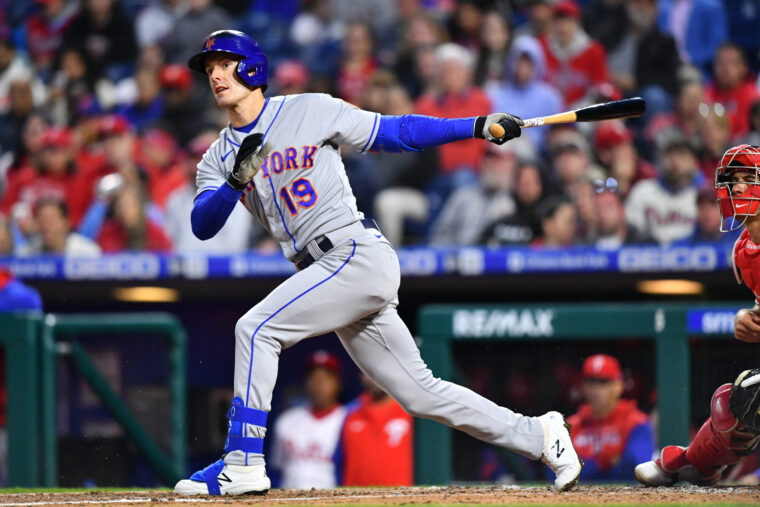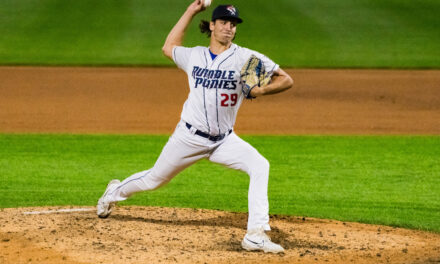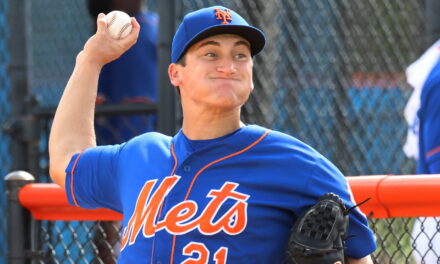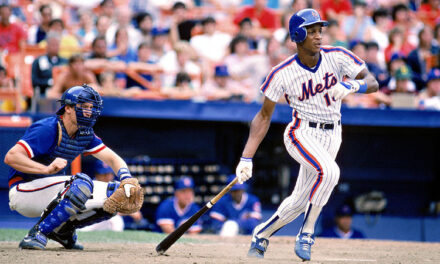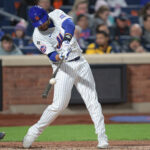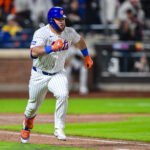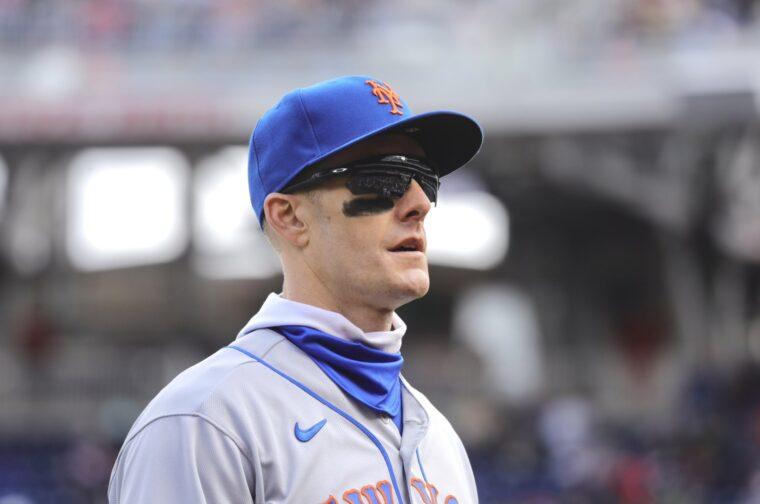
Mark Canha
After spending his first seven big league seasons with the Oakland Athletics, Mark Canha was ready for a change.
Following the 2021 season, the California native was entering free agency for the first time in his career and was ready for new opportunities.
After being drafted by the then Florida Marlins in the seventh round of the 2010 Draft, Canha was selected in the 2014 Rule 5 Draft by the Colorado Rockies at the request of the Athletics, who arranged a trade for the right-handed hitter.
In his rookie season of 2015, Canha posted a 1.4 bWAR in 124 games, and tied for the third-most home runs by an American League rookie that year with 16.
Canha’s breakout year occurred in 2019, when he hit a career-high 26 home runs and posted a .396 on-base percentage in 126 games. Among 169 hitters with a minimum 450 plate appearances in ’19, Canha recorded the ninth-highest wRC+ with a 146 mark.
When the New York Mets showed interest following the ’21 season, Canha, 33, was enthralled with the high stakes and challenges that come with playing in the Big Apple.
In late November 2021, Canha and the Mets agreed to a two-year, $26.5 million deal that included a club option.
His on-base prowess and defensive versatility were two of his main calling cards, as Canha had logged over 700 innings in all three outfield spots and first base heading into the 2022 season.
His .377 on-base percentage from 2019 through the 2021 season was ranked 11th among qualified major league hitters, and his 130 wRC+ was tied for the 10th-highest among qualified American League hitters in that span.
His Mets tenure got off to a great start in the month of April, as Canha posted a .345 batting average with a 140 wRC+ in 63 plate appearances. However, of his 19 April hits, only one was for extra bases (a double on April 29th). Over his first 96 games of the ’22 season, Canha recorded just 18 extra-base hits, posting a higher on-base percentage (.368) than slugging percentage (.367) up to that point.
After making some mechanical adjustments at the plate, Canha’s power surged at the end of the season. He recorded 19 extra-base hits in his final 44 regular season games from August 15th on, and recorded the third-highest ISO on the team with a .208 mark.
Along with his versatility and plate discipline, Canha came to the Mets with a penchant for compiling many hit by pitches. From 2019-2021, Canha had the second-most hit by pitches in all of baseball with 55, behind only Anthony Rizzo with 60.
That continued with the Mets, as Canha set a new team mark for most hit by pitches in a single season with 28; six more than the previous record holder (Brandon Nimmo, 2018).
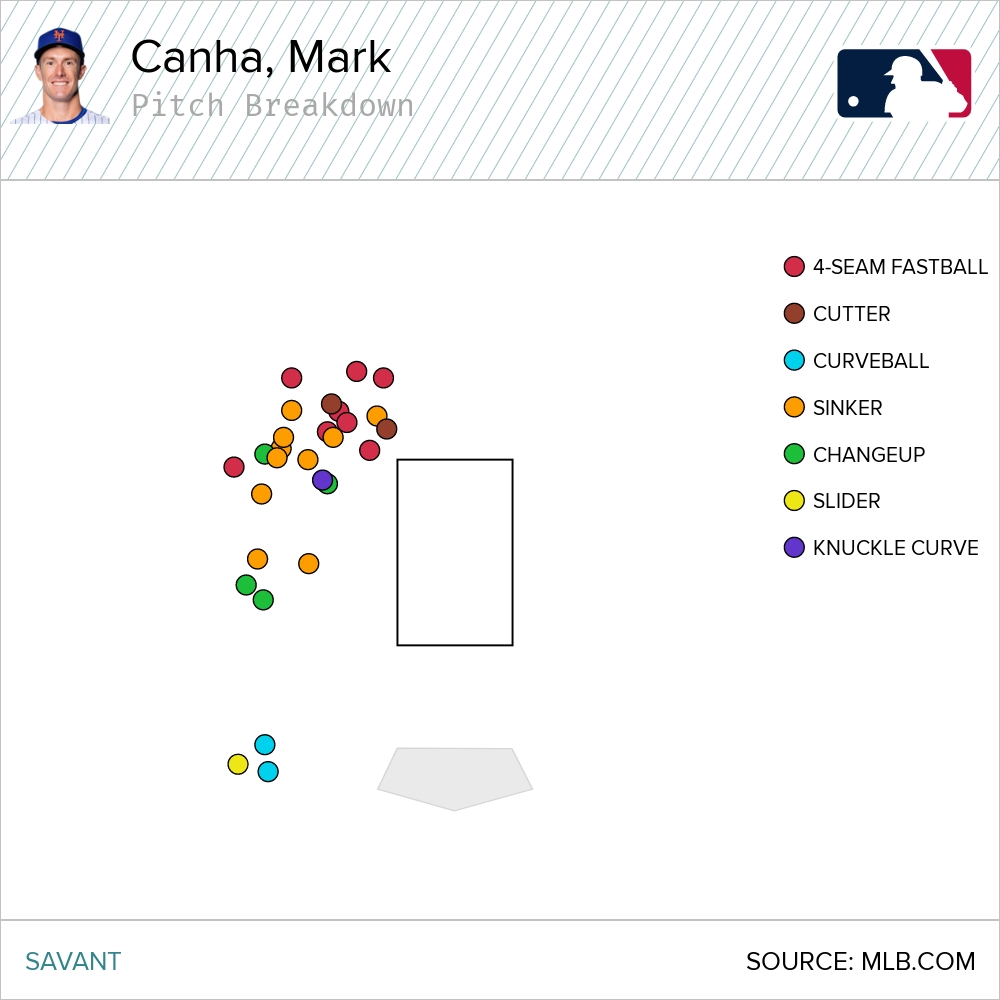
Location and pitch type of Mark Canha’s 28 HBPs in 2022.
In his first season with the Mets, Canha appeared in 140 games, hitting 13 home runs and posting a 122 OPS+. Canha was one of six Mets to post an OPS+ of at least 120 in ’22 (min. 500 plate appearances), the most players the club has rostered in a single season in franchise history.
I had the privilege of speaking with Canha in late December, where we discussed his time at the Cape Cod League, the adjustments he made to increase his on-base percentage and what made New York an appealing destination.
MMO: Who were some of your favorite players growing up?
Canha: I liked watching Barry Bonds, he was probably my favorite player. I was a Giants fan growing up in the Bay Area. I loved Manny Ramírez and Chipper Jones.
MMO: Where did your love of baseball originate from?
Canha: I wouldn’t say that I loved baseball growing up. I liked playing sports and I was athletic, and baseball was one of the sports that I played. But I wouldn’t even say that it was my favorite sport.
Baseball is fun if you’re good at it, and not fun if you’re not good. Once I started getting good at it, which was probably when I played Little League and got to the major division when I was ten, then it started being fun.
Up until then, I wouldn’t say I was any type of above-average player. I was just learning the game. I felt like I got good and then it started becoming more fun.
MMO: You played in the Cape Cod League in the summer of 2009. I’ve always heard such great things about that league and the player development overall. What are your memories and takeaways from your summer spent there?
Canha: A lot of memories. I had a great host family that I really loved. They would serve us great food, great local seafood. They were the most Cape Cod couple and were so welcoming. My family would come out and they were welcoming.
Other than that, I don’t have very many nice things to say about the Cape Cod League. I don’t like those collegiate summer baseball leagues, there’s something off.
I played for the Brewster Whitecaps and I’ll give you an example of what you have to go through as a player. The first day we show up and have a gym meeting at the field. We thought it was going to be an introductory thing. We get there and the home field is at an elementary school, and the grass at the field is up to our knees! We’re like, we have a game here in two days, what’s going on? They told us the other reason we were there, other than introducing us to the team and staff, is we had to cut the grass and make the field in some sort of playable shape. We had the whole team out there rolling up their sleeves.
Then they mentioned that there was an expectation that you have to get a job and help out in the community. I wasn’t opposed to that, but you’re there to play baseball. You’re playing baseball every day and that takes energy out of you as a young kid.
My job was to go to school every day and do maintenance. They were great guys, but I was painting walls all day for hours. I was like, I have a game tonight, what am I doing here? I’m exhausted and showing up to games exhausted which are supposed to be important to my career and getting to the professional level and being seen by scouts. I’m playing at rinky-dink fields that are just terrible and in terrible shape, and making errors in the outfield because the grass is just terrible and it’s not even a baseball field.
Long story short, I did okay but I ended up breaking my hamate bone in the summer, so I didn’t have a great experience. I don’t understand why it’s such a big deal. Cape Cod is a beautiful place and it’s a fun being around the guys and running around Cape Cod is not a bad racket. It felt like it was such a serious thing but then they were like here are all these caveats to how big of a deal it is.
It’s seemingly not well put together and it just feels like you’re playing some kind of unofficial league. It’s something that’s very important for young players to do well and show off their skillset at. I don’t know what it’s like now but when I was there, there was a lot left to be desired playing in that league. It wasn’t something that I enjoyed that much.
It is romantic in a way, they made that “Summer Catch” movie and a lot of scouts do come out and it’s the premier collegiate baseball league. But it’s just like, what are we doing? Find somebody to put some money into this thing so it can be real and not just whatever this is.
MMO: After your major league debut on April 8, 2015, in which you went 3-for-5 with four RBI, you paraphrased the famous Crash Davis media line from “Bull Durham.” Did you plan that or was that off the cuff?
Canha: I kind of planned it. I didn’t know I was going to pull it out in that moment.
I had never been in a true big league spring training prior to that season. I got picked up in the Rule 5 [Draft] and then I was in big league camp with the A’s, so I had never been exposed to the media before.
I quickly learned that sometimes they’ll ask you questions that as a young guy and not having experience at that yet, I didn’t know how to answer all the time. They were asking me these weird questions that I felt were impossible to answer.
I thought that was just my way of dealing with those questions at that time. I thought that was cliché and would be funny if I did that.
MMO: Do you have a favorite baseball movie?
Canha: I think my favorite baseball movie is “For Love of the Game.” I like that one a lot.
MMO: You went from a .328 on-base percentage in 2018 to a near .400 on-base percentage in 2019 in a similar number of games. Did you make a change in your approach at the plate or alter anything mechanically to see your on-base percentage rise as it did between those two seasons?
Canha: I always get asked this and it was a very specific thing. At the 2018 All-Star break, I was just thinking about how the year was going. It was going well but I was just feeling that there was something missing. Why are my numbers not as good as they should be, kind of thing.
I looked up and down the roster and was like, How do these guys get there OPS so high? I looked at my numbers and my slugging was pretty good at the break, but my on-base percentage I was like, Man, I’m not getting on base, I’m not walking.
I remember the day after the All-Star break I went in early, and we had our first game of the second half in Oakland. I immediately went on the computer and started watching video. I literally started from my first at-bat of the year and watched every single at-bat of the first half. Just on a straight watch, not pausing or anything.
I watched the at-bats and was asking myself, Why am I not walking? Are people attacking me?
I realized that anything remotely close to the strike zone I was swinging at. I was making a lot of bad outs with weak contact. I just said to myself, This seems like some low-hanging fruit that I can address pretty easily if I just shrink the zone and be more selective and more selective with the pitches I’m swinging at. Just try to attack pitches that are more in the middle and let the pitchers have strikes and see what happens. Why not? I wasn’t doing as well as I thought I should be doing.
I started doing that and trying to make a steady consistent effort. I had to tell myself in the on-deck circle, Hey, we’re doing this, we’re doing this. It has to be a real adjustment, you can’t just say you’re going to do it. You have to stick to it.
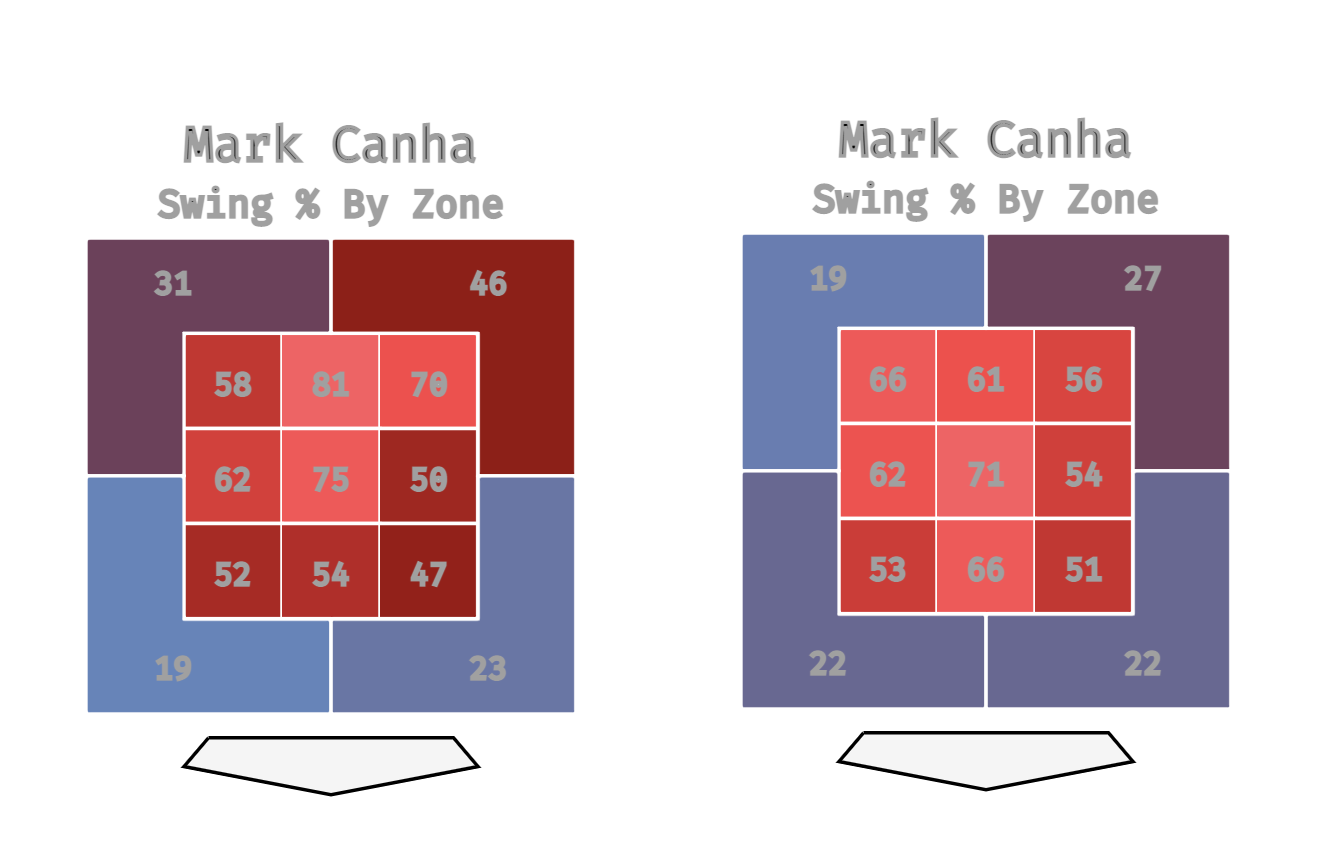
Mark Canha’s 2018 (left) and 2019 (right) swing % by zone.
I committed to sticking to that plan and it obviously worked, you can see it in the numbers. I’ve been a more selective hitter ever since then and it’s helped me a lot.
MMO: What drew you to sign with the Mets?
Canha: I met with Billy [Eppler] and Sandy [Alderson] in the offseason. I loved their personalities and meeting with them they were pushing hard. I could tell that they had a vision for the offense and for the team.
It seemed like an organization that wanted to change, and I wanted to change and do something completely different which was being in the National League and on the East Coast. That was a very different thing than I was used to. It just felt like that was something that was appealing to me, just doing something completely different.
New York was appealing to me. I’m a big food person, as everyone knows, and I think the big market and the big stage is something that I was really craving and found it hard to turn down. I think a lot of people would be intimidated but I thought whether this goes good or bad it’s an experience that I need to have. I have to see what it’s like to play baseball when the stakes are high.
I wanted that experience in my life as part of my career.
MMO: Has there been anything about playing or living in New York that’s surprised you?
Canha: No. [Laughs.] The reason I say that is because you have sort of a hyperbolic expectation. It’s kind of exactly what I expected. The scrutiny, the big stage, the city, just being in the city and how loud it is and how passionate people are for their teams.
People were coming up to me all the time and recognizing me and it was kind of great. It was everything and more that I wanted it to be.
MMO: Since 2019, you’re tied with Anthony Rizzo for the most hit-by-pitches with 83, including a single-season A’s record of 27 in 2021, and a Mets record of 28 in 2022. You’ve mentioned several reasons in the past on why that total is so high, including your proximity to the plate, not always moving out of the way of pitches and perhaps not being liked.
Has being hit so often changed your mindset or approach at the plate, or has the frequency become second nature at this point?
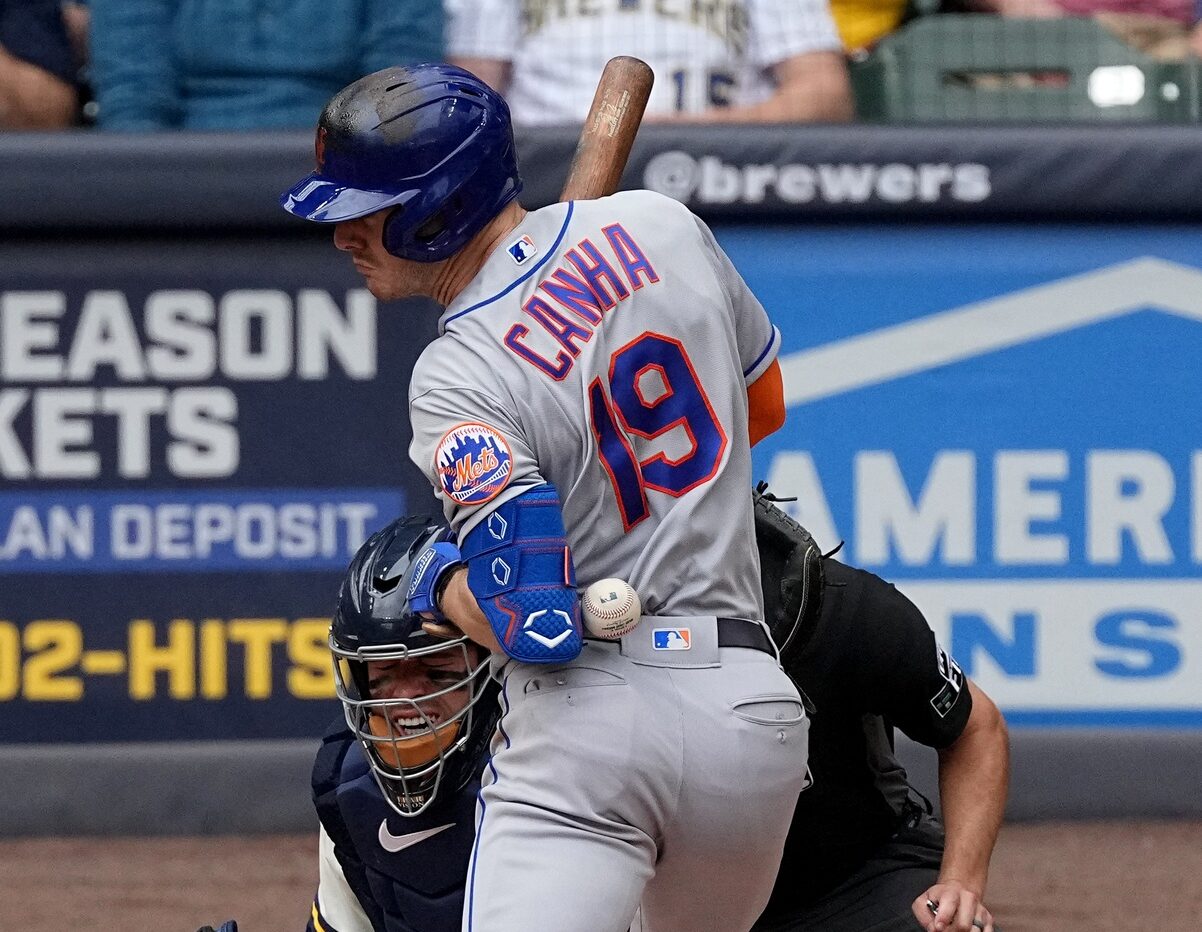
Mark Hoffman/Milwaukee Journal Sentinel-USA TODAY Sports
Canha: I think it’s become second nature. It’s not something I think about; I’m not up there trying to get hit by a pitch or trying to get closer to the plate. It’s just something that’s become habitual with not recognizing those moments when the ball is in the air. Like, oh, this pitch is coming in tight and is just not moving. It’s kind of a muscle memory thing.
I don’t even know how it started, I can’t explain it. In 2019, I did make an effort to get closer to the plate and kind of dare guys to go in there. That kind of went along with my approach, too.
Along with being more selective another thing I tried to do in ’19 and was kind of successful [with] was I realized that I was pulling the ball pretty successfully. I should just get on the plate because I’m handling the inside pitch pretty well and try to pull. Forget about using any other part of the field, just hit it down the line and pull everything.
I was having a lot of success doing that. It was kind of like a thing where I felt it and was like, Yeah, I can do that and be successful. It’s not an easy thing to do because I try it now and it doesn’t work and I’m like, I’m not hitting that pitch or controlling that half of the plate.
Once I got close to the plate, naturally you’re going to start getting hit a little more and that’s what happened. And I was like, That’s a good thing, that’s going to help your on-base, being more productive and scoring more runs. That’s kind of my mentality: don’t move, let it hit you. Why are you getting out of the way? If you can wear those pitches that’s another weapon you have.
You can see the frustration on the opposing pitchers’ face. They’re pissed because that’s a baserunner and they didn’t want that to happen and now so-and-so is coming up or whatever the case may be. That’s a weapon.
MMO: Through your first 96 games with the Mets, you had a total of 18 extra-base hits. In your final 44 games of the regular season, you recorded 19 extra-base hits. After the game against Colorado in late August, you talked about making an adjustment in your setup and limiting your movement. Can you talk about when you first became aware that something was off, and what kind of work you did in order to alter that?
Canha: The numbers didn’t lie, I was hitting for a really high average the first month, and I don’t think I had an extra-base hit in April (Canha had one). It was great that I was hitting over .300 (.346), and for the whole month to hit over .300 is pretty solid. There are not many months in my career where I’ve done that, but it was going to catch up to me because they were all singles.
I knew deep down that it was not sustainable and needed to fix something without sacrificing a lot. We have to make a serious adjustment here to try and get some power.
I was with the hitting coaches and trying to get the ball in the air and use my legs a little bit more and kind of figure it out. It was something I battled all year. It was a tough year for power in general with the way the baseballs were, and we weren’t anticipating that. I think it was a down year for most people power-wise, power was down across the board. That was frustrating.
But the numbers don’t lie, I was not hitting the ball in the air enough. My launch angles, you can only blame that so much and I knew. I was like, I can’t even hit a double! We just worked on some stuff and used my legs and hips a bit more.
Unfortunately, it’s not something that I can pinpoint. It’s a day-to-day process that takes a long time and I’m expecting the work that I did in the second half of last year and the work this offseason will keep moving forward and progressing. It’s just one of those things in baseball, it’s little, micro-adjustments that you have to make because you’re always weary of if I make a big change then I can fall into a slump.
Obviously, I was doing something well by seeing the ball, but it’s just about trying to generate my body in a more efficient way. That search is unfortunately never ending for me and that’s my journey.
MMO: You mentioned the work you put in with the hitting coaches. What was it like working with Eric Chávez?
Canha: He was great. It was a great team with Chavey and Jeremy Barnes.
Chavey and Barnes are very different in the way they teach and what they teach. Chavey helped me so many times throughout the year. He’s so good at bringing you back to kind of foundational hitting ideas that you have to do to be successful like having a strong base, being stable and balanced. That’s stuff that he had to remind me of throughout the course of the year when I was trying to make adjustments. It’s like, you can do these adjustments that are advanced hitting adjustments you can say that are highly technical, but at the end of the day, you have to still do these other things well to make them work.
Jeremy was what I call the upper division hitting guys and Chavey is kind of hitting 101. You need both to be successful, I think.
MMO: Your go-ahead, two-run home run off now new teammate David Robertson on August 21st was such an incredible game and comeback. Was that the best bat flip of your career?
Canha: [Laughs.] I don’t know. I think I’ve had better ones.
There weren’t many this year, I didn’t hit many home runs so it’s kind of hard to do it. But whenever I flip the bat it’s just a spur-of-the-moment thing and not something that’s premeditated or anything. Whatever I’m feeling at that moment is what comes out, that’s just me being me and coming from inside. I’m kind of a wear my emotions on my sleeve-kind of person, and that bat flip manifested in how it happened.
It was just a big moment, and I was in a zone that game and I kind of knew it. I was just elated to finally have a game where I showed some power. We talked about the power thing and I finally found something. I think I hit a couple of homers the week before and things were starting to click a little bit.
It was a build-up of emotions up to that moment and that’s what you saw there.
MMO: From a player perspective, have you kept tabs on what the club has done this offseason? What are your thoughts on the job Steve Cohen has done with the organization?
Canha: It’s awesome. What more can you ask for? It’s a lot of fun and its craziness and creates hype and that’s why I love playing for the organization and this version of the Mets. This team is just awesome.
I love the kind of counter-reaction that our owner is having to the rest of the league, and I like how he’s going against the grain and ruffling feathers. I think that creates a dynamic and an atmosphere within our organization that’s a lot of fun and a lot of pride and that’s a great thing.
MMO: It’s well-known that you’re a big food guy, and you post great pictures on your Instagram page. When did this appreciation and love of food begin for you, and how did that food account come about?
Canha: Growing up, I would say my dad’s cooking inspired my passion for food. Not at the time, I think at the time as I kid, I didn’t eat all of his food at times. My siblings and I thought it was strange that he was making these gourmet dishes that he would make out of Food and Wine Magazine. He still has this recipe book that he made, it’s just cut-outs from magazines that’s compiled into a binder. He’d cook out of this thing and make some crazy dinners, and I didn’t even like it at the time.
Once I got older and my palate got a little more refined, I think the stuff that I was unfamiliar with wasn’t as uncomfortable. It was a normal thing to be exposed to strange things. That’s kind of how I developed my passion for food.
Then once I went to Cal Berkeley, the Bay Area is a very diverse place and there’s a lot of different options at Berkeley. It’s a great place to go visit if you ever get the chance. It’s beautiful and there are a lot of different perspectives and cultures represented in the food scene in the Bay Area in general.
I was exposed to a lot of Asian food that I had never had like Thai, Korean and Indian; stuff that I had never had before growing up just because I wasn’t interested in trying it. Now other people are eating it and it’s in vogue to go to places at Berkeley and hang out. I drank the Kool Aid and was into it.
In the offseason right before I made it to the big leagues, one of my ex-teammates at Cal was at this event there, and I was talking to his wife. She was saying how she did a food blog and had an Instagram account that she documents food on and had a bunch of followers. She said it was a lot of fun and enjoyed going around to different places in the Bay Area. I thought it was cool as hell and sounded like so much fun.
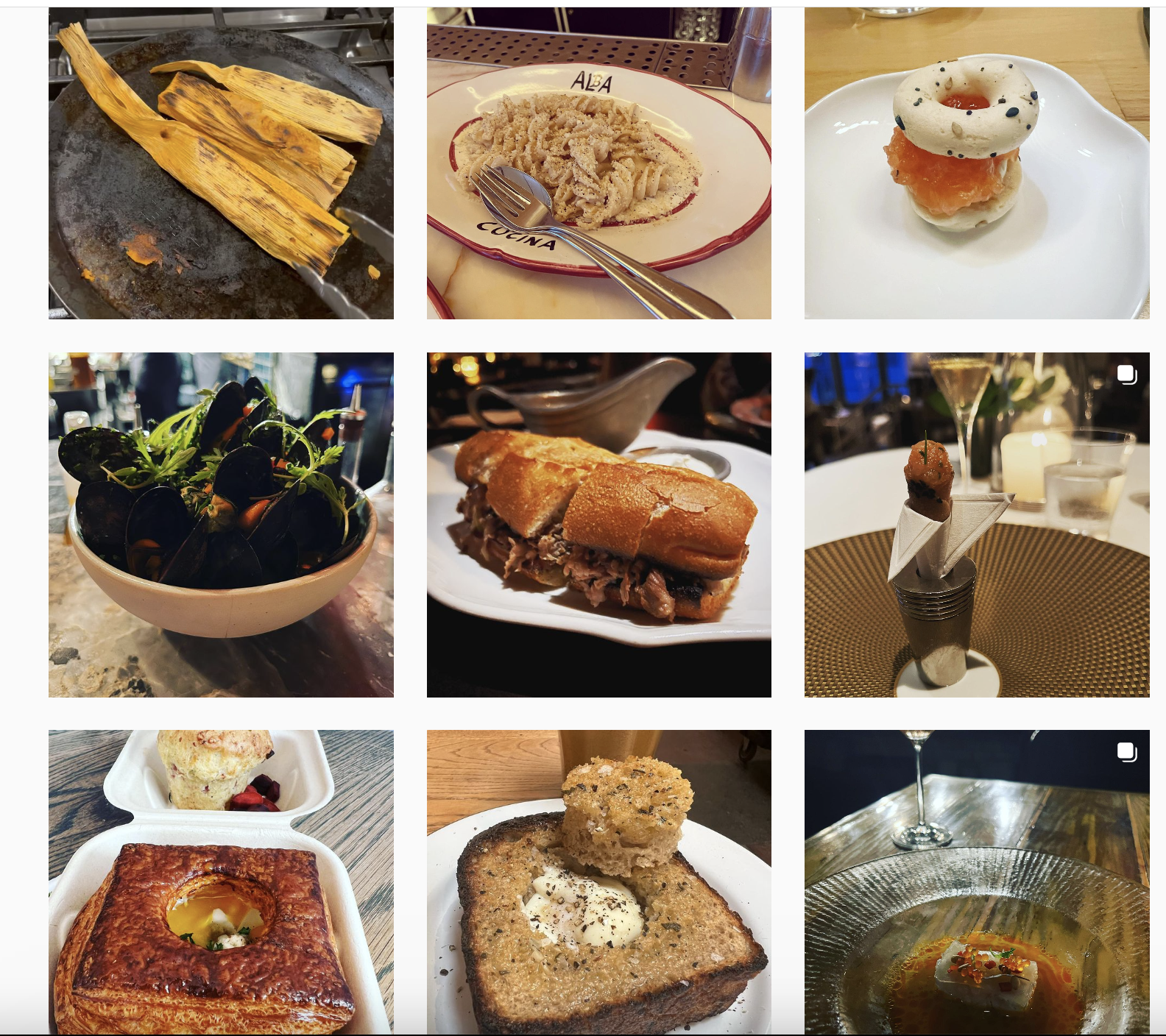
Pictures from Mark Canha’s Instagram.
I didn’t have an Instagram account at the time. I wasn’t into Instagram and I really didn’t see any use for it for me. I told her I was going to copy her idea and she was like, “Sure, why not?”
I knew that the baseball platform would be another way to add a dynamic to it that would make it interesting.
MMO: Thanks for your time today, Mark. Enjoy the rest of your offseason and best of luck in 2023.
Canha: Thanks very much.
Follow Mark Canha on Twitter, @outtadapakmark


